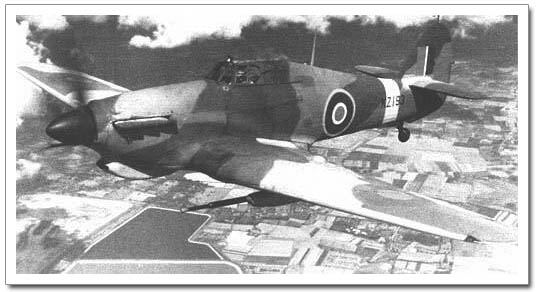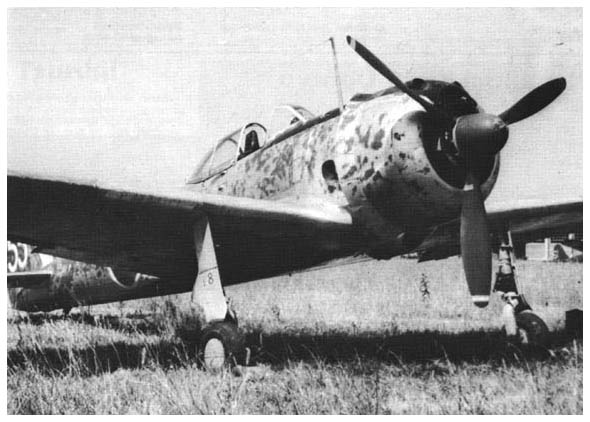
The F4U was one of the most successful fighters of WWII. It achieved a claimed 11.3 to 1 'kill ratio' in the Pacific. It was fast, but had some handling problems, and early versions tended to 'bounce' upon landing because of their stiff undercarriage. Therefore it was at first restricted to land-based marine units, and equipped all USMC fighter units in the Pacific in the second half of 1943. After some modifications, it was used also for shipboard operations, but continued to require careful handling. The vast majority of WWII F4U sorties (54470 out of 64051) were flown from land bases. The F4U had an inverted gull wing, a streamlined fuselage of circular cross-section and a big propeller. The cockpit was set well back, and the restricted view was a serious problem.
Wing span: 12.49 m
Lenght: 10.13 m
Height: 4.50 m
Weight (max): 6,592 kg
Propulsion: 1x Pratt & Whitney R-2800-18W
Speed (max): 684 km/h
Service ceiling: 11,245 m
Armament: 6x 12.7mm machine gun, 2x bombs or 8 rockets
Bomb load: 900 kg
Crew: 1
British Hawker Hurricane Mk.IV

Hurricanes equipped 26 RAF squadrons at the beginning of the Battle of Britain and shot down more enemy aircraft than all other defences combined. The RCAF received its first Hurricanes in August 1939, including those flown by Number 1 Squadron RCAF in the Battle of Britain. Later in the war, Sea Hurricanes were launched by catapult from ships at sea to defend convoys against air attack. A "tank buster" version with 40mm cannon was used in North Africa.
Wing span: 12.2 m
Lenght: 9.8 m
Height: 4 m
Weight (max): 3,023 kg
Propulsion: 1x Rolls-Royce (Packard) Merlin XX V
Speed (max): 560 km/h
Service ceiling: 10,365 m
Armament: 2x 40mm cannon, 2x 7.7mm MG, 2x bombs or 8 rockets
Bomb load: 226 kg
Crew: 1
Russian Yakovlev Yak-3

Basically a member of the Yak-1 and Yak-9 family, the Yak-3 was a stripped down airframe optimised for close-in dogfighting. First encountered by the Luftwaffe at the Battle of Kursk in the Summer of 1943, it was soon realized that the Yak-3 was a formidable opponent and by 1944 an edict had been handed down by the forbiding engagement of Yak-3's below 5,000m.
Wing span: 9.2 m
Lenght: 8.50m
Height: 2.39m
Weight (max): 2,660 kg
Propulsion: Klimov VK-105PF-2 V12
Speed (max): 650 km/h
Service ceiling: 10,800 m
Armament: 1x 20mm ShVAK, 2x 12.7mm MG
Bomb load: n/a
Crew: 1
German Focke-Wulf Fw190 D9 "Dora"

Considered by many as the best German fighter of World War II, the Focke Wulf 190 was built to flank the already excellent Messerschmitt BF 109. The 190 proved to be powerful, agile and versatile, more than 20,000 of these small compact aircraft were built, 13,367 of which were interceptors while the rest were fighter-bombers. In 1944 the Fw-190D was developed. The 190D became known as the Long-Nose "Dora", due to the lengthening of the nose to accommodate the installation of the huge Junkers Jumo 213A V-12 engine. This was the most successful version of the entire family of 190's due in large part to the huge 2,240 hp generated by the new engine. The Fw-190 D-12/R21 for example, the fastest of all the 190's reached a maximum speed of 453 mph (730 km/h) at altitude.
Wing span: 10.50m
Lenght: 10.2m
Height: 3.35m
Weight (max): 4,840kg
Propulsion: Junkers Jumo 213A-1
Speed (max): 704km/h
Service ceiling: 10,627m
Armament: 2x 13mm MG 131, 2x 20mm MG 151/20, 1x bomb
Bomb load: 500 kg
Crew: 1
Italian Macchi MC.202 "Folgore"

The Macchi MC.202 "Folgore" was simply an MC.200 "Saetta" modified to take the 1,075 hp Daimler-Benz DB601A, already successfully proven in many fine Luftwaffe aircraft, such as the Messerschmitt Bf109. The performance improvement was vast, a clear 60mph faster than its predecessor, proving itself for the first time on 10th August 1940. The aircraft soon proved itself to be more than a performance match for Hawker Hurricanes and most others, beaten only by the Spitfire and the Mustang. However, the DB601A engine was in hot demand, and so Alfa Romeo started manufacturing it under license, as the R.A.1000 RC.41-I, and was in fact rated slightly more powerfully at 1,200 hp. By late 1942, there were more Folgores in the Regia Aeronautica than any other type. Records are obscure, but it is believed about 1,500 Folgores were completed. However, certainly less than 400 came directly from Macchi factories, the rest constructed by Breda and Ambrosini.
Wing span: 10.58m
Lenght: 8.85m
Height: ???
Weight (max): 2,937 kg
Propulsion: Alfa Romeo R.A.1000 RC.41-I
Speed (max): 600 km/h
Service ceiling: ???
Armament: 2x 12.7mm Breda-SAFAT MG, 2x 7.7mm Breda-SAFAT MG
Bomb load: n/a
Crew: 1
Japanese Nakajima Ki-43 IIIb Hayabusa

The Ki-43 was the single most numerous fighter operated by the Imperial Japanese Army. Comparable to the A6M Zero-Sen, the Ki-43 was highly manueverable but fragile and tended to disintegrate when hit by .50 rounds. Later versions had some armor and self-sealing fuel tanks but all models suffered from a lightweight armament (though the IIIb tried to rectify this). The Ki-43 was popular with pilots and was the mount of a majority of the Japanese army aces. Unfortunately it was kept in production long after it was obsolete.
Wing span: 10.83 m
Lenght: 8.92 m
Height: 3.27 m
Weight (max): 2,850 kg
Propulsion: Nakajima Ha-112 Kasei
Speed (max): 585 km/h
Service ceiling: 11,215 m
Armament: 2x 20mm Ho-5 cannon, 2x bombs
Bomb load: 250 kg
Crew: 1




 This topic is locked
This topic is locked












